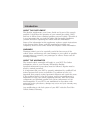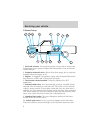
12. Two fuel tanks- Located underbody to facilitate fuel system design.
13. Stone and heat shield- Protective shield able to prevent damage to
the fuel tanks caused by road debris or other road hazards.
14. High pressure fuel lines- Delivers high pressure fuel to the
pressure regulator.
15. Pressure regulator and fuel filter assembly- Reduces the fuel
pressure to the fuel injection pressure of 125 psi.
16. Quarter turn valve- Isolates the fuel tanks from the rest of the fuel
system.
17. Low pressure fuel lines- Supplies 125 psi of natural gas to the
engine.
18. Fuel rail sensors- One injection pressure sensor and two engine
fuel temperature sensors provide engine fuel information to the PCM.
ADAPTERS
DO NOT use fuel receptacle adapters when refueling your vehicle.
The profiles of both the natural gas vehicle receptacle and the fuel
station nozzles are specified by ANSI/AGA NGV1-1994, CGA NGV1-M94.
These profiles are specified for compressed natural gas vehicles and fuel
stations for safety purposes. Three separate adapter profiles are
available. P24, P30 and P36 respectively, are specified for the three
different service pressures of 16 500 kPa (2 400 psi), 20 700 kPa
(3 000 psi) and 24 800 kPa (3 600 psi).
Your vehicle’s service pressure may be 20 700 kPa (3 000 psi) or
24 800 kPa (3 600 psi), depending upon application. Refer to the label
on the fuel filler door:
• If your vehicle’s fuel system is rated at 20 700 kPa (3 000 psi), it can
be refueled using a P30 or P24 nozzle. However, use of a P24 nozzle
will result in an incomplete fill.
• If your vehicle’s fuel system is rated at 24 800 kPa (3 600 psi), it is
refueled using a P36 nozzle only.
DO NOT over pressurize the CNG fuel system or damage to the
fuel system and possible personal injury may occur.
Servicing your vehicle
11


















